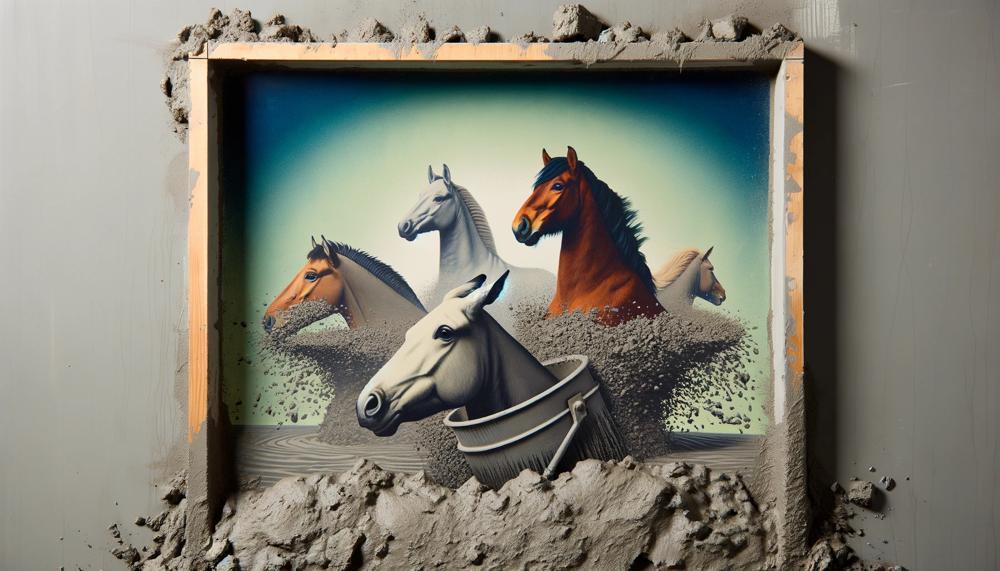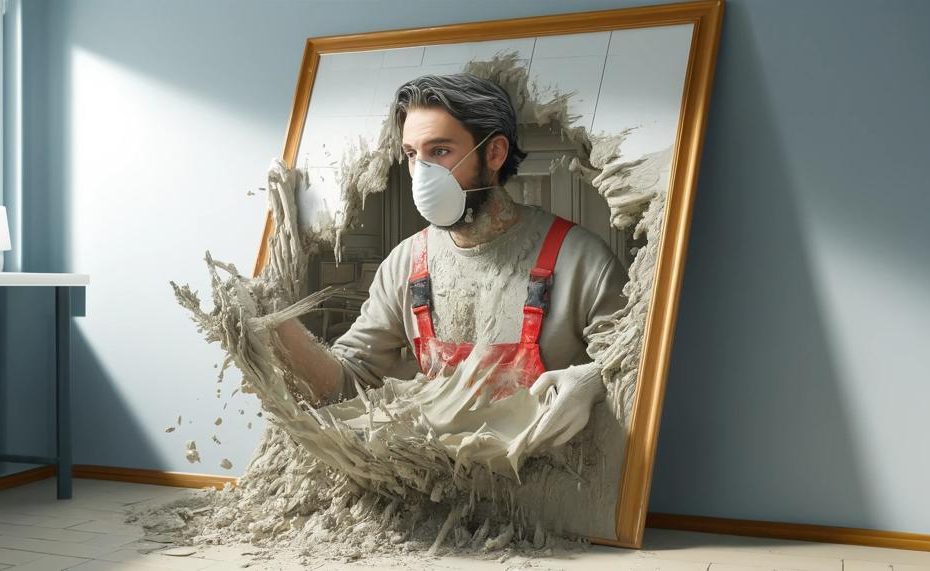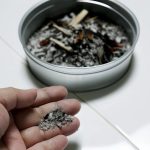Did you know that over 25 million tons of construction waste, including unused drywall mud, end up in landfills each year? This staggering amount underscores a significant, often overlooked aspect of home improvement projects: the importance of proper disposal methods for construction materials.
As seemingly innocuous as drywall mud may appear, its disposal requires careful consideration to minimize environmental impact and maintain compliance with local regulations.
In this blog post, we’ll delve into the most effective and responsible ways to dispose of drywall mud, ensuring that your renovation clean-up is as smooth and environmentally friendly as the rest of your project.
So, how do you dispose of drywall mud properly?
- Regular Garbage Service: How to safely include drywall mud in your household waste without violating local guidelines.
- Construction and Demolition (Candamp;D) Drop-Off: When and how to utilize Candamp;D centers for larger quantities of drywall mud.
- Household Hazardous Waste (HHW) Centers: The role of HHW centers in disposing of old, unopened drywall mud containers.
- Drywall Mud Reuse: Tips for reusing drywall mud to reduce waste.
- Special Considerations: Key precautions for disposing of drywall mud manufactured before 2016 to avoid potential hazards.
With these points in mind, let’s explore how to tackle the disposal of this common but cumbersome product, ensuring that your project remains tidy, eco-friendly, and compliant with all necessary waste disposal standards.
Contents
- 1 Is Drywall Dust Bad?
- 2 Why Is Drywall Mud Safe to Dispose of in the Garbage?
- 3 How to Properly Dispose of Drywall Mud
- 4 Is It Harmful to Use a Drywall Knife on the Floor?
- 5 How Do You Dispose of Drywall Mud Dust?
- 6 Keeping Yourself Safe While Disposing of Old Drywall Mud
- 7 Safety Measures When Disposing of Drywall Mud
- 8 Conclusion
Is Drywall Dust Bad?
Yes, drywall dust can pose significant health risks, primarily due to its content of gypsum and silica, which when inhaled, can cause respiratory problems and other health issues.
Potential Risks and Dangers of Drywall Dust:
| Component | Risks | Preventative Measures |
| Gypsum | Irritation to the lungs, eyes, and skin | Wearing PPE like masks and goggles |
| Silica | Silicosis, a long-term lung disease | Using dust extraction tools |
| Lead and Asbestos | Additional respiratory issues and severe health risks | Professional assessment and removal |
Preventing Negative Effects through Proper Disposal:
Proper disposal of drywall dust not only minimizes personal exposure but also reduces environmental contamination. Here are some effective strategies:
- Use of PPE: Always wear appropriate personal protective equipment, such as respirators (N95 or better) and protective eyewear.
- Dust Collection Systems: Implement dust collection systems in tools and vacuums during drywall installation and sanding to capture dust before it disperses.
- Regular Cleaning: Clean the work area frequently with a vacuum having a HEPA filter to prevent dust accumulation.
- Legal Disposal Guidelines: Follow local regulations for the disposal of construction materials, including drywall dust, which often require it to be taken to designated drop-off centers.
Conclusively, while drywall dust is hazardous, understanding its components, associated risks, and adhering to proper disposal and safety measures can mitigate potential negative impacts on health and safety.
Why Is Drywall Mud Safe to Dispose of in the Garbage?
Drywall mud, often used in building and renovation for smoothing walls, is deemed safe for disposal in regular garbage due to its non-hazardous composition. It typically contains gypsum, a mineral that is non-toxic and poses minimal risk to both human health and the environment.
Since drywall mud does not include harmful chemicals, it aligns with safety regulations for landfill disposal.
Here’s a detailed breakdown of the reasons why disposing of drywall mud in garbage is both safe and environmentally responsible:
| Non-toxic Ingredients | Gypsum and other compounds in drywall mud are not classified as hazardous. | Safe for landfills without leaching harmful substances. |
| Legal Compliance | It adheres to environmental regulations that permit non-hazardous waste in municipal garbage systems. | Ensures compliance with local disposal laws. |
| Environmental Impact | Modern formulations of drywall mud, especially post-2016, meet high environmental standards. | Reduces the ecological footprint of building materials. |
| Special Considerations | Old drywall mud (pre-2016) may require specific handling to ensure safety due to potential older chemical formulations. | Adheres to updated safety guidelines for older materials. |
The safety of disposing of drywall mud in the garbage makes it a viable option for waste management during construction or renovation projects.
This method not only aligns with legal and environmental standards but also simplifies the cleanup process by allowing for direct disposal without needing special treatment or handling.
How to Properly Dispose of Drywall Mud
Safely disposing of drywall mud is a straightforward process that requires attention to detail to ensure environmentally friendly practices.
Materials Needed:
| Material | Description | Purpose |
| Garbage Bags | Sturdy bags capable of holding wet materials | For disposing of small amounts of drywall mud in household trash |
| Transportation | Truck or car | For transporting larger amounts to a CandD drop-off center |
| Protective Gear | Gloves, masks, and goggles | Essential if handling old drywall mud made before 2016 |
Steps for Disposal:
- Assessment:
- Determine the total amount of drywall mud to be disposed of.
- Small Quantities:
- If dealing with a minor amount, encapsulate it in garbage bags and add to your regular household trash.
- Large Quantities:
- For substantial amounts, plan a trip to a local construction and demolition (Candamp;D) drop-off center. Ensure the mud is dry and not leaking.
- Handling Pre-2016 Materials:
- Use protective gear when managing drywall mud manufactured before 2016 due to potential older chemical compositions.
- Unopened Containers:
- Old, unopened containers of drywall mud should be taken to a Household Hazardous Waste (HHW) center for safe disposal.
- Dried Material:
- Dispose of dried mud, particularly if attached to material chunks, at a Candamp;D center.
- Storage and Reuse:
- For any mud you plan to reuse, keep in the original container. Remove excess mud from tools and store dry. If the mud has separated, stir it well before reusing, discarding any excess water.
Is It Harmful to Use a Drywall Knife on the Floor?
Using a drywall knife on the floor is not recommended and can indeed cause damage or harm.
Drywall knives, designed primarily for cutting and shaping drywall sheets, possess a sharp blade that, if applied to flooring materials, could easily scratch or gouge them, especially on surfaces like wood, laminate, or vinyl.
Reasons to Avoid Using a Drywall Knife on the Floor:
- Scratching: The sharp edge of a drywall knife can leave significant scratch marks on softer flooring materials.
- Gouging: With improper handling, the knife can dig into the floor, causing gouges that may require costly repairs.
- Inefficiency: There are more appropriate tools designed for flooring tasks that will not only protect your floors but will also be more effective.
For tasks involving flooring, it is essential to select the right tool for the job to avoid unnecessary damage and additional repair costs. Tools like floor scrapers or utility knives, designed with appropriate blade angles and protective features, are better suited for handling tasks directly involving floor materials.
Comparative Analysis: Drywall Knife vs. Suitable Floor Tools:
| Tool | Primary Use | Suitability for Floors |
| Drywall Knife | Cutting and shaping drywall | Poor – risk of scratches and gouges |
| Floor Scraper | Removing materials from floors | Good – designed to be gentle on surfaces |
| Utility Knife | General cutting tasks | Average – better than drywall knives but requires careful handling |
How Do You Dispose of Drywall Mud Dust?
Proper disposal of drywall mud dust requires attention to environmental safety and local disposal regulations. Here’s a detailed guide on how to dispose of drywall mud dust safely and effectively:
| Method | Description | Precaution |
| Construction and Demolition (CandD) Facility | Take drywall mud dust to a designated CandD facility where it can be processed and disposed of properly. | Ensure the facility accepts drywall mud. Call ahead to confirm their policies. |
| Durable Bagging | Before transport, securely bag the dust in durable bags to prevent any leaks during transit. | Use heavy-duty bags to avoid tears or spills. |
| Household Garbage Disposal | If local regulations permit, you can add small quantities of drywall mud dust to your household garbage. | Consult with local waste management to ensure compliance with local laws. |
| Household Hazardous Waste (HHW) Center | For hazardous types of drywall mud, particularly post-2016 compositions, use an HHW facility for disposal. | Verify that the HHW center can handle this type of waste. Some centers might not accept all kinds of drywall mud. |
| Sweeping and Bagging | Use a broom to sweep up the dust and dispose of it in a sealed plastic bag with regular garbage. | Avoid using a household vacuum as it can damage the machine or spread the dust back into the air. |
| Shop Vacuum | Use a shop vacuum equipped to handle fine particles, then dispose of the vacuum bag as directed. | Check if the vacuum can handle drywall dust to prevent damage to the vacuum filter and motor. |
When dealing with drywall mud dust, it’s essential to follow safety precautions, such as wearing a dust mask and using proper ventilation.
Keeping Yourself Safe While Disposing of Old Drywall Mud
Keeping Yourself Safe While Disposing of Old Drywall Mud requires a straightforward approach to handling materials that can be potentially hazardous. Below, find a table outlining the essential safety precautions based on the outlined research. Adhering to these precautions ensures your safety and compliance with disposal regulations.
| Precaution | Details | Reason |
| Check Dryness | Confirm the mud is completely dry before disposal. | Avoids the risk of illegal dumping fines and environmental harm. |
| Use Proper Equipment | Employ a wet/dry or shop vacuum to remove the mud, ensuring all excess water is extracted. | Prevents clogging and ensures efficient disposal of moist material. |
| Protective Gear | Wear gloves, eye protection, and a respirator mask. | Shields against dust and irritants that can cause respiratory and skin irritation. |
| Skin Contact | Avoid direct skin contact with the dry mud. | Prevents skin irritation and potential allergic reactions. |
| Clean Containers | Thoroughly clean out any containers before reuse. | Ensures containers are safe for future use and prevents contamination. |
| Immediate Disposal of Contaminated Mud | Dispose of any mud that smells bad immediately. | Addresses potential contamination that could pose health risks. |
| Designated Disposal Area | Take the mud directly to a household waste drop-off center or an outdoor garbage bin. | Ensures proper disposal, preventing environmental pollution. |

Adhering to these guidelines will not only ensure your personal safety but also uphold environmental standards. Always wear the recommended protective gear and handle drywall mud with care, especially if signs of contamination are present.
Safety Measures When Disposing of Drywall Mud
Disposing of drywall mud, whether it’s surplus from a home renovation or a large-scale construction site, necessitates specific safety measures. It’s crucial to approach this task with a mind for not only ensuring environmental safety but also protecting oneself from potential health hazards.
| Precaution | Description | Reason |
| Wear protective gear | Utilise gloves, masks, and goggles | To avoid skin irritation and prevent inhalation of dust particles |
| Check for hazardous components | Particularly assess drywall mud produced before 2016 | Older mixes may contain harmful substances harmful to health and environment |
| Use original containers | Scrape excess mud back into the original containers | Facilitates easier, safer disposal and recycling |
| Proper drying technique | Allow mud to dry completely before disposal | Reduces the risk of spillage and makes transportation safer |
| Consult disposal regulations | Check local regulations for specific disposal guidelines | Ensures compliance with local environmental safety standards |
When disposing of drywall mud, it’s paramount to wear appropriate protective gear, including gloves and respiratory protection, especially when handling products made before 2016 which may contain hazardous materials. Always check your local disposal regulations; different areas might have specific requirements or designated facilities for disposal.
Scraping excess mud back into its original container not only minimizes waste but also reduces exposure to any toxic substances that might have been used in older drywall mud formulations. Letting the mud dry completely before disposal is a key step—wet mud is more difficult to manage and can be messier, increasing the risk of contamination.
Lastly, consulting local disposal guidelines ensures that you are adhering to local standards for environmental protection and waste management. These steps not only safeguard personal health but also contribute to the broader goal of environmental conservation.
Conclusion
To cap off our deep dive into the responsible disposal of drywall mud, it’s crucial to recognize the role each of us plays in curtailing construction waste. Annually, millions of tons of such materials clutter our landfills, but with the right knowledge and a bit of effort, we can significantly curtail this trend.
If you’re wrapping up a home renovation or a construction project, remember the variety of options at your disposal for managing leftover drywall mud. For small amounts, your regular trash service will suffice—just ensure it’s securely bagged. Larger quantities should be taken to a Construction and Demolition (Candamp;D) drop-off center, while any outdated or unopened products deserve a trip to your nearest Household Hazardous Waste (HHW) center.
Moreover, don’t overlook the possibility of reusing drywall mud. Storing leftover mud properly can save resources and reduce waste, allowing you to use it in future projects. Be particularly mindful when disposing of products made before 2016, as they may contain substances now recognized as harmful.
Navigating through these choices not only keeps your workspace clean and compliant with local regulations but also protects our environment. Every scoop of mud you recycle or dispose of responsibly is a step toward a more sustainable world.





